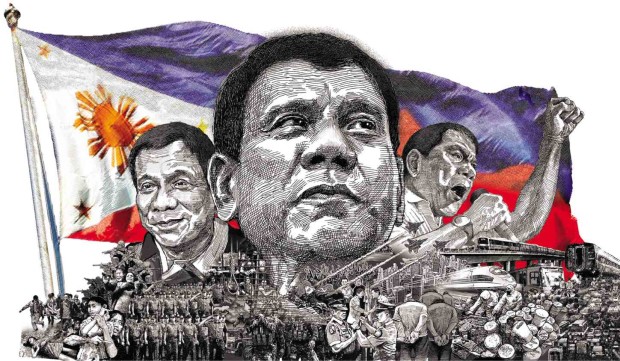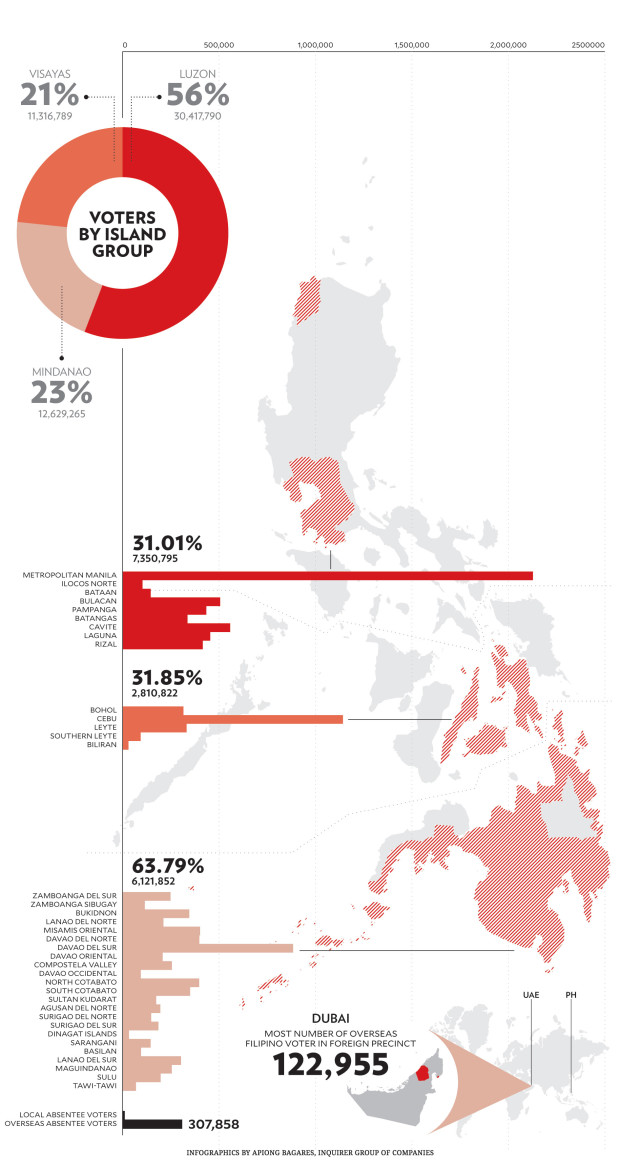Rody, Leni won thanks to ‘promdi’ appeal, ‘laylayan ng lipunan’
Philippine elections are won not by the thousands who comprise the educated elite but by the “laylayan ng lipunan,” the million others from far-flung barangays whose voices were often ignored and the disillusioned city dwellers still beset with problems that should have been solved by a booming economy and better job opportunities.
And in 2016, their message was clear: Let the Philippines be lead, for the first time in its history, by a tandem of “promdis” or probinsyanos, after 118 years electing only leaders who forged political careers in Metro Manila or studied abroad.
President Rodrigo Roa Duterte from Mindanao, 72 and the outgoing mayor of Davao City, spent majority of his life serving the southern capital of the Philippines. Vice President Leonor Gerona Robredo from Bicol, 52 and the outgoing representative of Camarines Sur, transformed her image from the widow of a humble public servant to a mother, guardian and advocate of the poor.
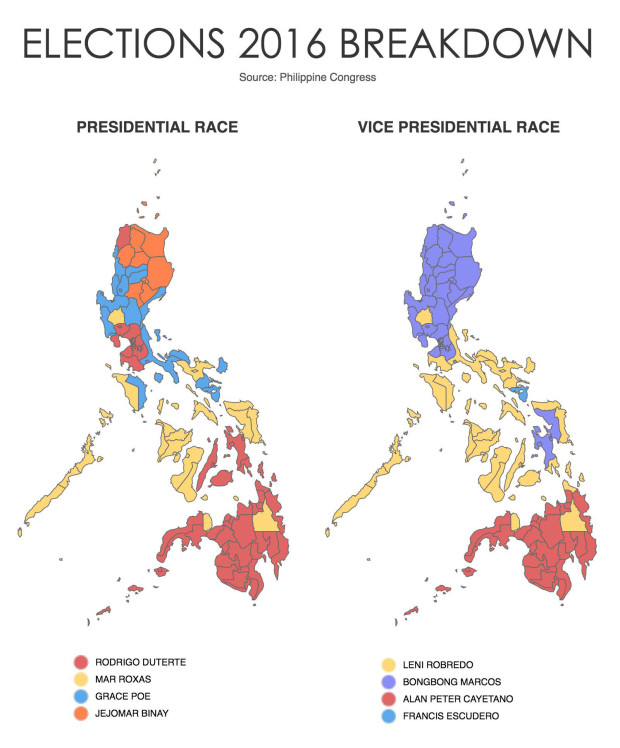
Duterte was the clear victor with 16,601,997 votes, or 38.99 percent of the estimated 42.6 million voters in an automated election touted as the most transparent in recent times. His closest rivals, former Interior Secretary Mar Roxas and Sen. Grace Poe, were at least 6 million votes behind, garnering 9,978,175 and 9,100,991 respectively.
Robredo won by a much slimmer margin of over 263,473, or 0.64 percent of all votes counted, over closest rival Sen. Bongbong Marcos, whose term ends on the day of the presidential and vice presidential inaugurations. The Camarines Sur representative garnered 14,418,817 total votes compared to Marcos’ 14,155,344 votes.
Duterte and Robredo are set to take their oaths as the country’s duly elected leaders on the morning of June 30, 2016.
Nationalistic, or regionalistic?
On May 9, an unprecedented 81.62 percent of an estimated 54.4 million registered voters cast their ballots, according to data from the Commission of Elections. Of that number, about 42.58 million chose a president while 41.07 million chose a vice president.
How to account for the high turnout? Election scholars turn to two of the biggest factors that have long explained Filipino voting patterns: ethnolinguistic regionalism and strong political alliances.
The 2016 elections were no different; at a glance, the map breakdown of ballots cast per province shows a divisive, but not unexpected election turnout.
Jan Robert Go, assistant political science professor from the University of the Philippines, said these two factors go hand in hand.
“You don’t take presidential elections and vice presidential elections separate from the entire picture of elections in the Philippines,” Go said. “In a more general sense, we also have to see how the national elections is connected with the local elections, especially how local candidates, for example, carry national candidates.”
Regionalism, according to election scholars, is when locals of one area vote for candidates who either come from the same town, province or region, or speak the same language. By voting for someone from their hometown, the logic is that the locals will get more attention from the government, thus addressing problems specific to that area.
Geography is not the only factor behind regionalism; speaking the same language also links provinces and regions otherwise separated by local events.
Regionalism is why Manuel L. Quezon, then Senate President, did not garner 100 percent of all votes for president in the 1935 elections. Regionalism is why Quezon has his runningmate, then Vice President Sergio Osmeña of Cebu province, to thank for the landslide victory in Bisaya-speaking provinces in Visayas and Mindanao. Only in two provinces did the eventual president lose: Ilocos Norte, the hometown of Aglipayan Church founder Gregorio Aglipay, and Cavite, the hometown of Emilio Aguinaldo, the country’s first president running for reelection.
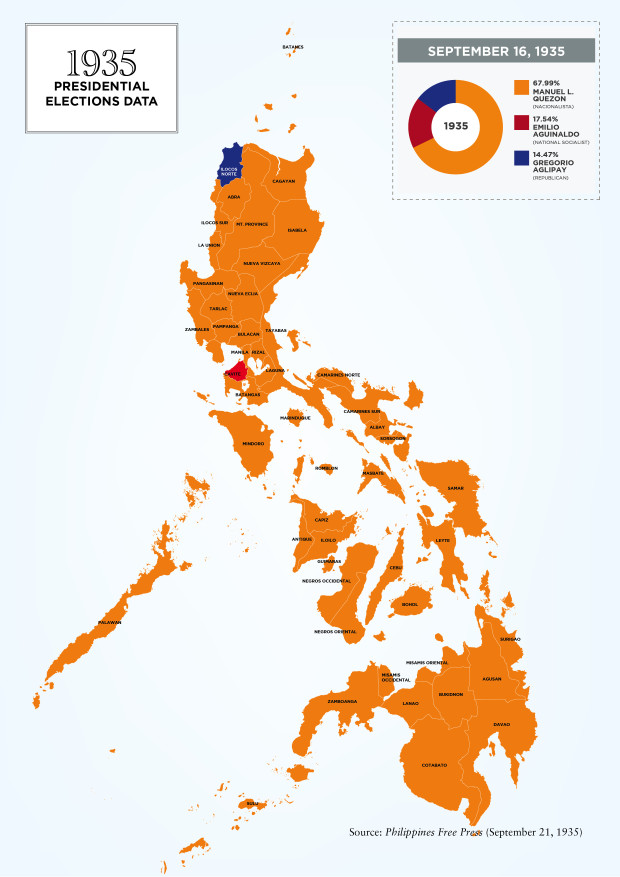
Breakdown of votes during the 1935 presidential race between Manuel Quezon, Emilio Aguinaldo and Gregorio Aglipay. Photo from the book “Philippine Electoral Almanac”
The trend continues in succeeding elections. In 1957, Claro M. Recto lost the presidency to Carlos P. Garcia after garnering majority of votes only in hometown Quezon and neighboring Batangas.
In 1992, four of the seven candidates for president won big only in their home provinces: Salvador “Doy” Laurel won only in Batangas, Imelda Marcos in Ilocos Norte, Jose de Venecia in Pangasinan and Sergio Osmeña III in Bisaya-speaking regions.
In 2004, Panfilo Lacson’s presidential bid prospered only in hometown Cavite.
In 2016, 614,192 residents of Davao City–96.59 percent of the turnout–cast their ballots for the long-time city mayor. In the whole Davao region, Duterte amassed at least 1.84 million votes, or 89.45 percent of all ballots cast for president.
In Camarines Sur, 664,190 votes– 85.57 percent of the total–went to Robredo. The Bicolano also garnered 63.88 percent of all votes in Region V; she could have gotten more, had Sorsogon not voted in favor of Sen. Chiz Escudero, who–unsurprisingly– is one of its own.
Regionalism is also prevalent in choosing candidates for other national positions other than the biggest two posts. Party-lists, for instance, rely heavily on provincial bloc voting to win seats. This elections, the Ako Bicol is the only party-list group that earned three seats in the House of Representatives, primarily because of Bicolanos’ bloc voting.
From national to local
Equally important to winning elections are political alliances formed between local government officials. Candidates running for higher office rely on their provincial bailiwicks to deliver “sure votes” for them come election time. In most cases, bailiwicks are formed when either a candidate has familial ties in a province or mayors, governors and congressmen from other provinces pledge support for a candidate who had helped them in the past.
Outgoing Vice President Jejomar Binay, for instance, considers Regions II and CAR his bailiwicks because he was the first to respond with aid when landslides and typhoons devastated the area. Marcos, too, considers northern Luzon his bailiwick because of his family’s decades-long partnership with the provinces nearest to Ilocos Norte.
Political alliances, however, are not always paraded or reported. “Politicians do negotiate and do talk to each other,” Go said, adding that underground campaigning and backalley deals are just as important as official pronouncements.
While Duterte’s official runningmate was Sen. Alan Peter Cayetano, many local politicians in Mindanao preferred and proliferated the Duterte-Marcos tandem. The favor was returned, where Sen. Miriam Defensor Santiago lost big to Duterte up north despite being Marcos’ vice president.
In Albay province, too, Liberal Party (LP) chair Gov. Joey Salceda switched allegiance to Poe less than a month before the polls. The end result: Roxas ended up with the most number of votes at 221,778, but Poe was only exactly 200 votes behind, at 221,578.
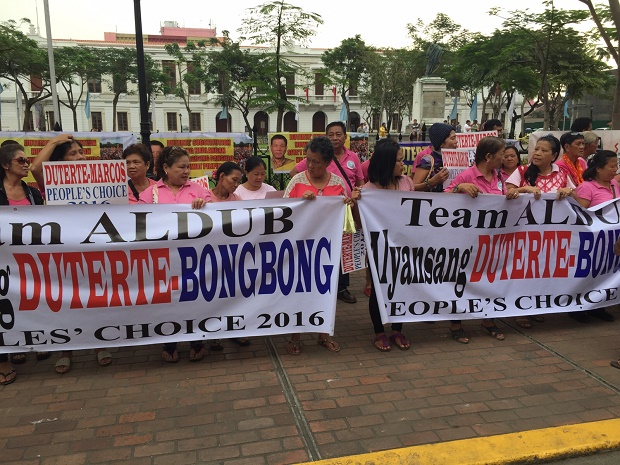
A popular, albeit unofficial, tandem in Luzon and Mindanao during the 2016 elections was between Duterte and Marcos. ARIES JOSEPH HEGINA/INQUIRER.net
“It does not follow that if you are from the Liberal Party, you would automatically endorse someone from the Liberal Party,” Go added.
Such is why provinces who voted for Robredo did not vote for Roxas, why students from the University of the Philippines preferred that Robredo be paired up with Senator Poe. After the two-party system was replaced by one that allowed multiple parties to nominate a president and vice president, Filipino voters were no longer limited to strictly choosing between tandems.
“Our institutional structure was opened to the possibility that the president and VP are not from the same party,” Go said. “The people now had an option.”
Vote breakdown
Between the five vying for president–six if you count the late Roy Señeres whose name remained in ballots despite his death–and six others vying for vice president, Filipinos in 2016 had plenty of choices. The presidential race was more tight, with Duterte’s double-digit lead in surveys coming only less than a month before May 9. The vice presidential race, however, was more often than not a two-way race between Robredo and Marcos.
At least 10 million of Duterte’s votes came from the 36 of 81 provinces where he led the race, which included Metro Manila and local and overseas absentee votes. In turn, almost 9 million of Robredo’s votes came from the 41 provinces she led in.
The meat of Duterte’s lead came from the bloc voting of a seemingly “Solid South” that extended beyond his Davao City bailiwick, which in total delivered for the Mindanawan 6,121,852 votes–63.79 percent of all votes from the island group and almost 40 percent of his roughly 16 million votes.
Only four provinces in the southern island group did not primarily vote for the Davao City mayor: Agusan del Sur, Camiguin, Misamis Occidental and Zamboanga del Norte, which swung in Roxas’ favor. The Liberal Party candidate, however, garnered only 19.99 percent of all votes in Mindanao.
Key endorsements from Cavite Gov. Jonvic Remulla and Cebuano local party One Cebu also translated into big wins for the Bisaya in those provinces. Duterte, in fact, breached 1.1 million, or 52.90 percent, votes in Cebu and clinched another 557,812 votes in Cavite, where he also garnered the most number of votes among presidential candidates.
The Mindanawan also won majority among local and overseas absentee voters.
In the vice presidential race, the bulk of Luzon and absentee votes went to Marcos, thanks to the so-called Solid North–an alliance comprised of Regions I, II and CAR–as well as a dominant showing in Metro Manila and Central Luzon. Mindanao, on the other hand, was a close three-way tie between Duterte runningmate Sen. Alan Peter Cayetano with 2,637,876, or 29.16 percent, of votes; Robredo with 2,529,956, or 27.97 percent; and Marcos with 2,088,749, or 23.09 percent.
Robredo’s path to victory was much less determined. She led only in the Visayas with 4,156,427 votes, which is 49.75 percent, or almost half the votes, in the island group. Majority of the vice president-elect’s Luzon votes came only from Regions IV-B and V, but a steady stream of votes from LP bailiwicks in Mindanao boosted her numbers to surpass Marcos by just enough.
Simple, noncomplex identities
Together, regionalism and strategic political alliances can explain in general why one province votes by bloc for only one candidate. But Philippine politics is almost always too messy to be confined to such trends. The dynamics of one area, according to Go, are almost always different from the dynamics of another.
One thread ties, outshines, transgresses all trends, based on history and culture: Nothing is more powerful for voters than a good story, one of perseverance and tagos sa puso, or straight from the heart.
Duterte and Robredo’s narratives are far from complex and easy to latch onto: One is a tough-talking, nonsensical “promdi” who promises to fix national problems using local solutions that have worked for him. The other, a widow and hands-on mother who wished only to continue her husband’s legacy to serve the people without grandeur or fanfare.
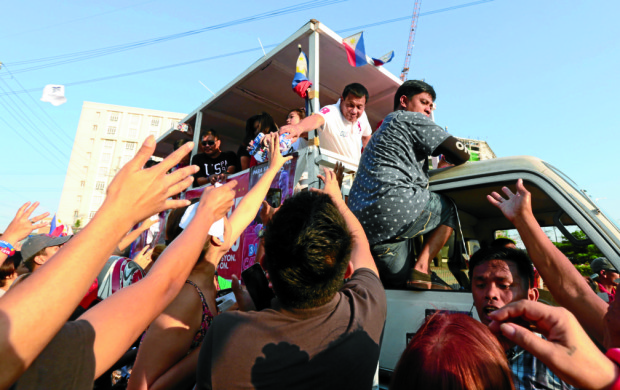
#INQBack: Then presidential candidate Rodrigo Duterte hands out t-shirt to waiting supporters during a motorcade with his running mate vice presidential candidate Sen. Alan Peter Cayetano in Pasay City on Sunday, May 1, 2016.
INQUIRER FILE PHOTO/GRIG C. MONTEGRANDE
Between all other candidates, it is Duterte and Robredo who are arguably most in tune with the plight of the ordinary Filipino; they, too, live equally simple lives, similar to the 88 percent who live outside of capital Manila.
Both chose to work and build careers in their home provinces away from the capital. Both did not seek to run for higher government posts until supporters catapulted their bids to national consciousness.
“Our politicians [generally] have provinces but they did not grow up in their provinces,” professor Go pointed out. “They are perhaps born there and stay until high school, but for college and work they go [to Manila]. They are exposed to politics here. And they register in their provinces only so they can run there in the future.”
Duterte and Robredo’s closest rivals–Roxas for president and Marcos for vice president–only highlight even more the oddity: Both second-placers are based mostly in Manila and both attained masters degrees in the United States.
Contrast that with how Duterte used to drive a taxi around Davao in the dead of the night, with how Robredo preferred eight-hour bus rides to and from Naga instead of one-hour plane rides thrice as expensive.
Their campaign promises were just as storied, taking cues from the “masa” appeal first used by President Ramon Magsaysay in his successful bid in the 1953 elections.
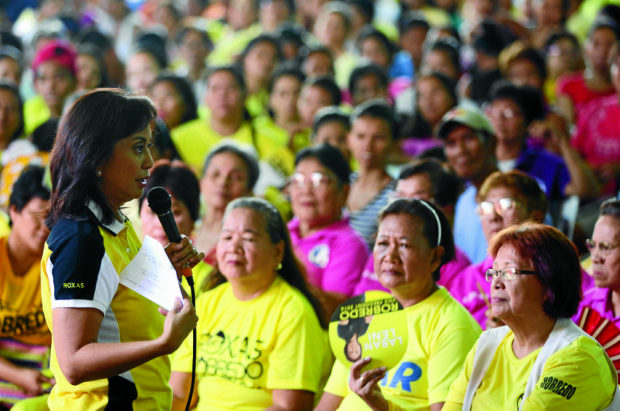
#INQBack: Liberal Party Vice Presidential candidate Leni Robredo delivers her speech at the residents of Tondo, Manila, April 7, 2016. INQUIRER FILE PHOTO/NIÑO JESUS ORBETA
Residents of Metro Manila and other developing cities took to heart Duterte’s ruthless stance on drugs, crime and corruption–three problems most especially felt by the urban poor closest to seats of power and economic growth.
Robredo did not promise to eradicate poverty by herself. Her platform rested instead on uplifting the poor, that they themselves be empowered to find solutions instead of waiting for dole-outs. In a GMA report, she also visited more provinces than any of her rivals, choosing to reach out to voters living on the literal margins of society, voters outside campaigners’ favorite Lingayen-Lucena corridor in Luzon in which over 20 million reside.
Neither Duterte nor Robredo won over majority of registered voters. But the Filipino electorate has spoken, as reflected in the numbers. May true change truly come under the first Mindanawan, that the best and last woman remain standing strong.
For more stories, photos and videos on President Rodrigo Duterte’s term as the country’s 16th President, visit The Duterte Administration special website at https://www.inquirer.net/duterte. View the full Duterte inaugural commemorative issue in today’s Inquirer Libre at https://inq.ph/inquirerepaper.











